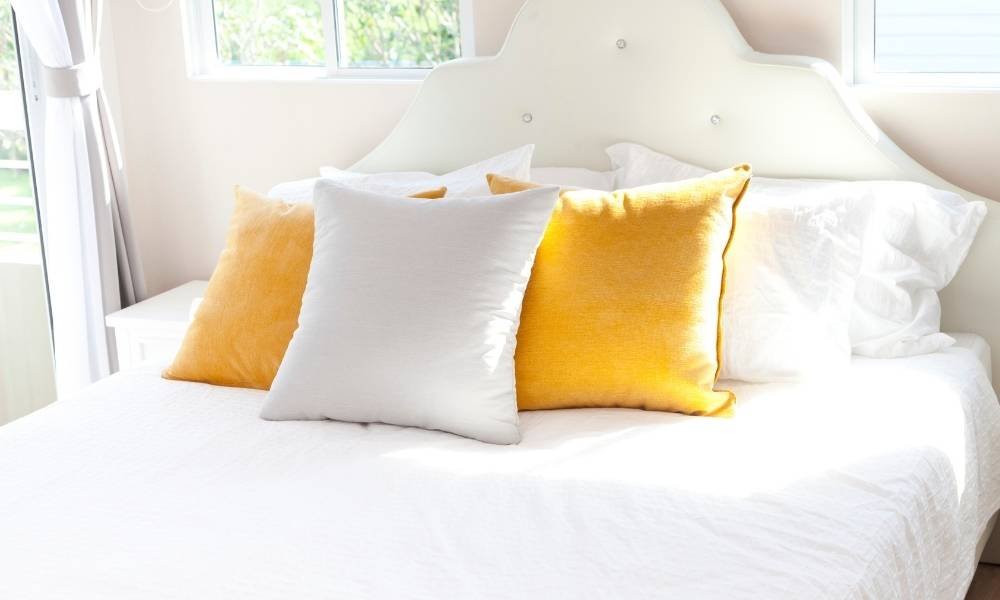Estimated reading time: 5 minutes
There’s nothing more annoying than trying to hit and fluff your flat and uncomfortable pillow into the right shape. Pillows are about much more than cuddling up to, they keep our necks and heads well supported as we sleep. A dodgy pillow can not only interrupt your sleep, but can also be the cause of aches and pains in the morning.
Like all good linen, keeping your precious pillows in great nick is key to a good night’s sleep. While they might feel like heaven at first, there comes a time when pillows need to be looked after. If you’re on the hunt for tips on how to keep your pillow fresh and fluffy, read on!
Washing your pillow
Pillows can easily accumulate dead skin cells, body oil, saliva, and even dust mites. While this can be relatively harmless for most people (albeit gross to think about!), for those with asthma and allergies, it can be a huge problem. That’s why keeping them fresh and clean is so important.
Washing your pillow, by hand or in the machine, may sound daunting – you don’t want to risk ruining it – but it can be done.
Machine washing
The first thing to do when washing your pillow is to read the tag to check if it’s machine washable or not. If it is, wash it on a lukewarm gentle cycle, with a small amount of laundry detergent (not fabric softener, as the shine it leaves behind can lead to more dead skin cells and body oil accumulating). After the first cycle, put it back in for a second spin or rinse cycle to get rid of any moisture and leftover detergent.
If your pillow is not machine washable, you’re going to have to wash it by hand.
Hand washing
You can hand wash your pillow by filling a tub or basin with lukewarm water, adding a small amount of laundry detergent, placing the pillow in the tub, and gently kneading and squeezing it (but don’t wring it as this can cause damage or even tear it), so it’s exposed to enough water and detergent for a good wash. Much like washing your pillow in the machine, after you’ve hand-washed it, give it another rinse with cool water to get rid of any excess detergent, gently squeezing as you go.
Before washing your pillow, whether it’s by machine or hand, remember to remove any pillowcases or pillow protectors. If you’re wondering how often you need to wash your pillow, it’s generally recommended at least twice a year, but you can wash it more often (say, every three months) if you wish.
Drying your pillow
After washing your pillow, you’re going to have to dry it. The first thing to do is to check whether it can go in the dryer or not.
If it can go in the dryer, use low heat and fluff it a few times so it has the best chance to go back to its original shape once it is dry. If it can’t go in the dryer, lie it down on a flat surface in a cool, dry room inside, or under shade outside.
While it may be tempting to hang your pillow up with your clothes, it will only lead to the pillow losing its shape, so step away from the clothesline and pegs for now!
Pillowcases and protectors
As well as washing and drying your pillow properly, another way to keep it fresh and fluffy is by using pillowcases and pillow protectors.
Pillow cases and protectors generally serve the same purpose – to prolong the life of your pillow by providing a barrier between it and any dead skin cells, body oil, saliva, and dust mites. Their main difference is that the pillowcase has an opening on one side, whereas the pillow protector completely covers the pillow without any openings or gaps.
While using one or the other will protect your pillow for a while, using both at the same time will definitely help keep your pillow fresh and fluffy, and prolong its life. Pillowcases and pillow protectors should be changed and washed at least once a week.
When all else fails…it’s time to say goodbye
While washing, drying and covering your pillow will keep it fresh and fluffy, and prolong its life, it will have to be replaced eventually. If your pillow has become lumpy, flat, broken up inside, and/or you can’t get rid of stains anymore, it’s time to bid your pillow farewell and find a new one. Just like linen, make sure you invest in quality pillows that are going to last a while!
How long a pillow lasts depends on its material and how well you care for it. On average, polyester pillows can last up to 12 months, whereas, on the other end of the spectrum, latex pillows can last up to five years.
Once you master these tips, you can easily make your next pillow fresher and fluffier for longer. We’re sure you won’t ever want to go back to a lumpy, flat pillow ever again!



